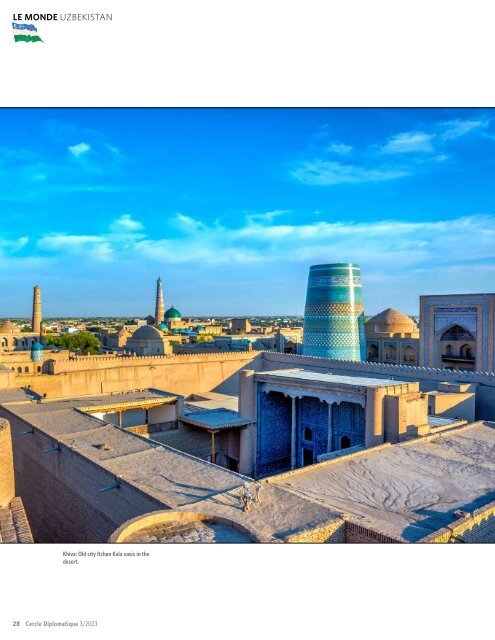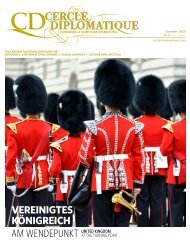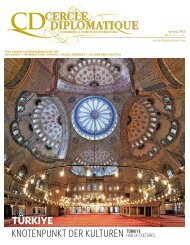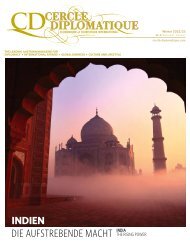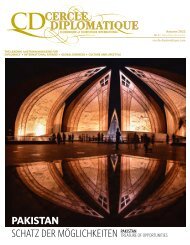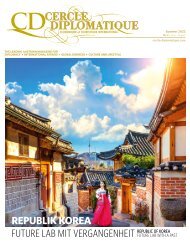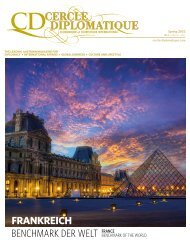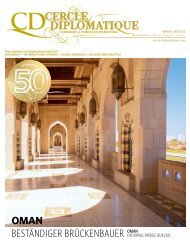CERCLE DIPLOMATIQUE - issue 03/2023
CD is an independent and impartial magazine and is the medium of communication between foreign representatives of international and UN-organisations based in Vienna and the Austrian political classes, business, culture and tourism. CD features up-to-date information about and for the diplomatic corps, international organisations, society, politics, business, tourism, fashion and culture. Furthermore CD introduces the new ambassadors in Austria and informs about designations, awards and top-events. Interviews with leading personalities, country reports from all over the world and the presentation of Austria as a host country complement the wide range oft he magazine.
CD is an independent and impartial magazine and is the medium of communication between foreign representatives of international and UN-organisations based in Vienna and the Austrian political classes, business, culture and tourism. CD features up-to-date information about and for the diplomatic corps, international organisations, society, politics, business, tourism, fashion and culture. Furthermore CD introduces the new ambassadors in Austria and informs about designations, awards and top-events. Interviews with leading personalities, country reports from all over the world and the presentation of Austria as a host country complement the wide range oft he magazine.
Create successful ePaper yourself
Turn your PDF publications into a flip-book with our unique Google optimized e-Paper software.
LE MONDE UZBEKISTAN<br />
Khiva - aerial view<br />
(left), TV tower in<br />
Tashkent.<br />
UZBEKISTAN<br />
PHOTOS: ADOBE STOCK<br />
Ancient towns along the Silk Road such as Samarkand,<br />
Bukhara and Khiva alone justify a<br />
visit to Uzbekistan. Anyone admiring the<br />
three ornate madrasahs from the 15th century on Registan<br />
Square in Samarkand will quickly succumb to<br />
the magic of the Orient. In the city of Bukhara, just a<br />
two-hour train ride away on the new Afrosiyob highspeed<br />
rail, the main attraction is the Poi-Kalon complex<br />
of 12th century structures, including the 46 metres<br />
high minaret with the Kalon Mosque, which<br />
seats 10,000 worshippers. Even Genghis Khan is said<br />
to have been so impressed by the buildings that he<br />
spared them.<br />
The most beautiful buildings go back to the ruler<br />
Amir Timur, (also called Tamerlane), who in the<br />
14th century created a world empire from today’s<br />
Uzbekistan that stretched from Asia Minor through<br />
Persia and India up to China. Uzbekistan owes many<br />
of its monuments with the typical domes covered<br />
with turquoise tiles to this ruler, who was in no way<br />
inferior to the Mongol prince Genghis Khan in terms<br />
of cruelty and warfare.<br />
No wonder, Timur is revered today as the ancestor<br />
of modern Uzbekistan. Evidence of this is his<br />
museum in the capital Tashkent and monuments in<br />
his native town of Shahrisabz and in Samarkand.<br />
Timur’s favourite grandson, Ulugh Beg, left battlefields<br />
to devote himself to science and especially<br />
astronomy. With an observatory including a built-in,<br />
huge sextant in Samarkand, he measured the solar<br />
year between 1424-28 so precisely that only a few<br />
hours differ from today’s measurement. He also detected<br />
and described over 1000 stars. Thus, Ulugh<br />
Beg found out about 100 years before Galileo Galilei<br />
that the earth revolved around the sun.<br />
Amir Timur immortalized his favourite wife Bibixonim<br />
with the mosque named after her in Samarkand,<br />
which was built in 1399 as the then largest<br />
mosque in the Islamic world. Timur’s traditional<br />
motto: “If you doubt our power, look at our buildings!”<br />
After the collapse of the Soviet Union in 1991,<br />
Uzbekistan became independent. The first president<br />
was Islam Karimov, who ruled with an iron fist and<br />
initiated the country’s upswing in an authoritarian<br />
manner.<br />
Official name: Republic of Uzbekistan<br />
Form of government: Presidential<br />
constitutional republic<br />
Population: 35.2 million<br />
Capital: Tashkent<br />
Area: 448,900 km 2<br />
Official language: Uzbek, Russian<br />
widespread<br />
Currency: Som<br />
GDP per capita: 8,000 US Dollar (2022)<br />
Skyscrapers in the capital Tashkent.<br />
Khiva: Old city Itchan Kala oasis in the<br />
desert.<br />
28<br />
Cercle Diplomatique 3/<strong>2023</strong><br />
Cercle Diplomatique 3/<strong>2023</strong><br />
29


